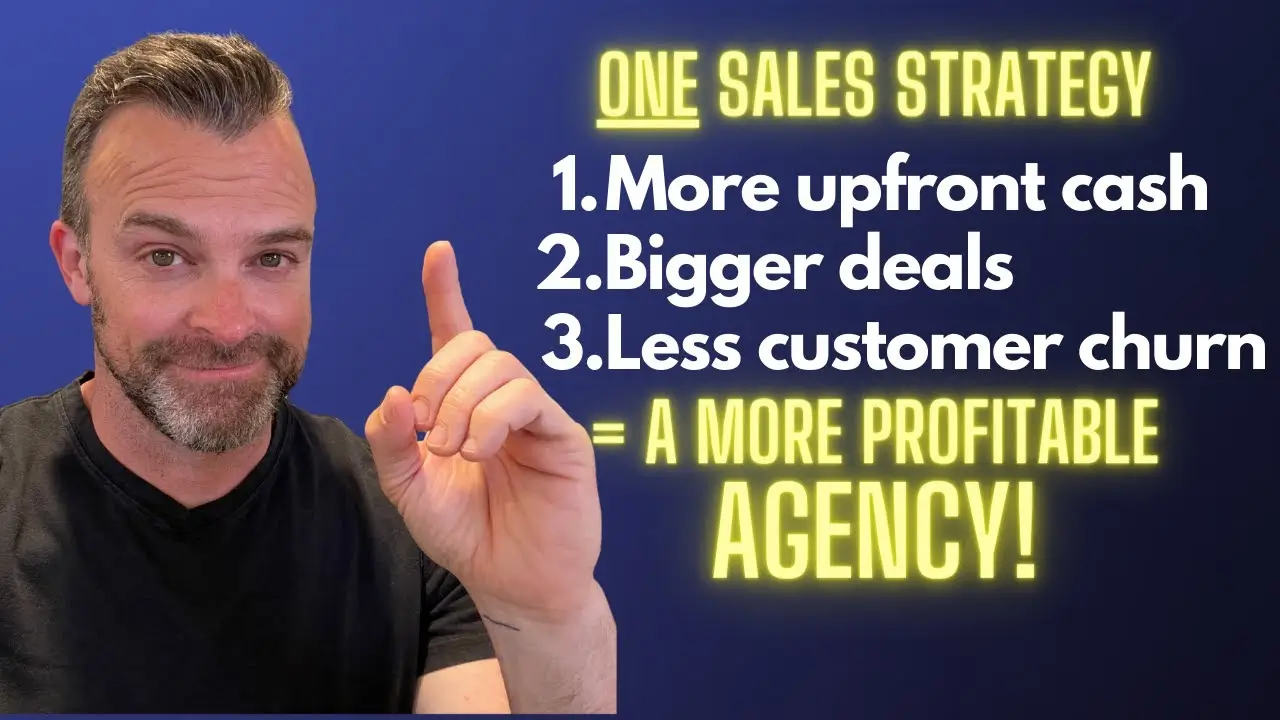Selling marketing services, software, and tools to small business customers is touted as a huge untapped opportunity for digital agencies and SaaS providers.
But learning how to grow your Digital Marketing Agency can be a challenge that many struggle to ever solve.
With over 30 million small businesses in operation across America alone, the surface-level size of the potential market makes it seem like anyone could build a sizable company just by grabbing a tiny fraction of it.
But the reality most agencies face is an uphill battle trying to generate enough revenue just to keep the lights on and grow, much less reach those 7-figure dreams.

One of the biggest factors holding them back is cash flow struggles driven by a flawed sales structure.
In this post, I’m going to teach you the number one strategy to beat the numbers and succeed as a digital agency. You’ll learn how to get more cash from your customers and also get them to stick around longer.
The great thing is that you can create more customer success with just one very important change to your approach and how you’re selling.
Grab My Free Training
Learn the Four Best HighLevel Services to Start a Digital Agency FAST!
A Flawed Sales Model
You see, most agencies attempt to sell customers small standalone packages priced affordably on a monthly subscription model. Things like:
- $97/mo website hosting
- $197/mo CRM and marketing automation
- $297/mo social media management
In theory, stacking a number of these low-cost services could produce healthy customer LTV over time. And the low entry price points seem attractive to cash-strapped small business owners.
However, this approach often fails to account for the full cost of acquiring customers in the first place—both financial and time costs. When you bake in things like:
- Paid ads—Google, social media, etc.
- Outbound sales calls and emails
- Free trials and discounts
- Sales team salaries
- Owner’s time selling
You rapidly recognize that landing a signed customer chews through $500 to $2,500+ on average.
For simpler services sold completely online, it might only be $200-$800. But for agencies selling customized packages into niches like law firms, dental offices, etc.—requiring phone calls and account management—that number can balloon higher.
And that turns low monthly service revenue into a huge problem. If your customer acquisition costs are on the higher end, it takes 4-6 months just to recoup what you spent to land that customer in the first place!
Now calculate your monthly net burn rate. Factor in any additional delivery team members, salespeople, and operational overhead on top of marketing just to support customers. It adds up fast.
Pretty quickly you realize you need BIG sales volume just to not hemorrhage money every month.
Attempting to shorten the payback period by charging higher monthly rates fails too. Over $1,000/mo and you massively shrink your eligible market of potential small business buyers.
Plus even healthy SMBs shy away from big monthly commitments.
Caught between high CAC and narrow revenue options, most agencies find themselves facing dismal choices:
- Bleed dry striving for volume that rarely materializes
- Attempt serving larger customers and abandon the “small biz” dream
- Close up shop within 12–18 months as the pressures overwhelm
But what if instead of tweaking metrics at the margins, you fundamentally reshaped this model?
Your savior lies in modifying the WAY you package and sell services rather than what you sell.

By leveraging upfront prepayments and annual billing, agencies can transform customer acquisition economics while ALSO improving experience.
The Secret that Hubspot Discovered
Study any agency, and churn looms large. Customers disappear every month due to a perceived lack of value, changes in budget, switching to competitors, etc. This translates directly into the consistent new sales pressure discussed above.
However research has identified a clear strategy for reducing churn drastically while accelerating revenue growth in one move: collect prepayment—the longer, the better.
Long-time small business software leader HubSpot analyzed internal data and discovered that across factors like services purchased, niche, marketing levels, etc.—ONE variable stood far above the rest for predicting retention and growth:
Did that customer prepay, specifically for 12 months or longer, at the start?
Even after adjusting for higher base prices on annual plans, they found this one choice to hugely impact eventual customer success.
And it makes perfect sense when you think about it:
- You only prepay when you expect high value from something
- Prepaying creates mental accountability to maximize the usefulness of your investment
- You must proactively cancel unpaid renewals allowing companies the opportunity to rescue issues
- Annual commitments prevent constantly questioning monthly bills
This dynamic transcends software services—think about gym memberships requiring annual fees to join or cell phone companies pushing prepaid 6–12 month packages. Or enterprise agencies earning multi-million dollar retainers upfront for big marketing projects.
They ALL understand this core concept:
Prepayment fuels commitment, drives satisfaction and enables growth.
So if you currently sell purely monthly, move revenue recognition from 30 days to 365.
Customers receive built-in success scaffolding while companies win reliable cash flow and higher LTV.
It’s one of those rare win-win market corrections fixing opposing problems simultaneously.
And you might worry upfront annual billing limits volume by introducing large dollar commitments. But as we’ll see in a moment by getting creative with packaging and payment flexibility, the market likely has more room than you imagine…
Customer Acquisition Costs Solved!
Now realistically very few companies in hyper-competitive spaces like martech software or fitness pull ALL revenue recognition forward 365 days. But you don’t need to. Because CAC recovery only requires covering your first 90 days or so in the red.
Let’s return to that initial example of selling a service for $500 monthly. Remember it costs you ~$2,500 to land them factoring multi-channel marketing, sales calls, promos and discounts, etc.
So you don’t break even until month #5, burning $5,000+ building towards that point. Very hard to sustain rapid growth dragging that anchor.
But now change the approach—sell a prepaid annual plan for $5,000 instead of $6,000.
Sure you offer a $500 loyalty discount, but structure it with an initial payment of $3000 then a quarterly collection of $1000.
With ONE conversion you immediately slash CAC losses by over half. Then become profitable in under 60 days by collecting the next installment. Both problems are massively relieved with one pricing model innovation.
Additionally, compare expected customer lifetime values between the two. Monthly obviously resigns you to those constant churn risks we want to avoid.
But IF that hypothetical customer stays for 3 years, you earn $18,000 over time.
Flip to annual prepay for the same customer at the discounted $5,000 rate. After 3 renewals you bank $15,000. But consider massively higher retention rates thanks to forced commitment mentalities. This quickly overcomes the discounting gap through lower attrition.
And that’s with a subtle pricing model shift. You can further optimize applying this same value/cost/revenue recognition concept across all your core offerings.
Now realistically you likely can’t jump directly to a 100% large upfront collection from everyone. But with some savvy packaging and segmentation explorations you can improve cash positions immediately.
Present Annual Upfront as the Default
Once you’ve rebuilt your pricing mixes around these principles, the first presentation becomes everything. Set customer anchors at annual prepayment plans out the gate.
Because given the option of course they’ll choose limited commitment. And you just leave huge money on the table long term.
But be prepared—once 12-month figures get floated many naturally push back.
That financed gym membership requiring a year upfront works when you tour impeccable facilities with a sales deck on the health dangers of sitting…
…Less effective if the couch calls first asking to join remotely for Netflix binge recovery!
Same here—that $5,000 platform subscription causing instant sticker shock must come wrapped with immense value. Through things like proven ROI calculators, airtight service guarantees, and complementary goal-planning sessions.

Otherwise, expect “Can I just do monthly?” responses.
Don’t derail everything by countering with rate hikes though. Anchor annual prepays as defaults, then offer încremental discounts in exchange for multi-quarter commitments.
Suddenly you guide customers towards, “If annually is too much can I do quarterly? Seems like this returns way more than it costs…” which keeps momentum rolling.
Using Packages and Payment Plans to Bridge Commitment Gaps
Avoid leaving initial calls with outright month-to-month signups if possible. But also don’t chase good customers away stuck on 12-month prepay demands.
Leverage packaged deals with creative payment schedules to find mutual ground.
One proven tactic splits annual plans into four milestone payments. Each directly corresponds with a service delivery phase completion over the year.
An SEO package for doctors might be structured like this:
- Full Year Fee = $6000
- First Payment = $2000—Keyword Research & Technical Optimization
- Second Payment = $2000—Content Strategy & Creation
- Third Payment = $1500—Link Building & Indexing
- Final Payment = $500—Performance Analysis & Goal Review
So that initial prepayment chunk still hits a big number to make meaningful revenue recognition impact. While also matching tangible progress customers make towards goals at each billing event.
You can creatively customize payment plans even further broken down into smaller monthly amounts without destroying too much forward revenue benefit.
Just ensure anytime you spread recognition across smaller increments, increase absolute dollar figures collected to account for that lost gap.
Businesses don’t successfully operate on charity. And the rare customer insisting on bare bottom rates likely won’t stay long regardless. So set optimal plans for what top-tier clients will accept and let the rest walk away.
Overcome Your Financial Mental Blocks
Now inevitably despite the math supporting this approach, you’ll probably find internal friction on actually floating large annual sums routinely.
And I faced the same self-limiting mental discussions for a while. Who reasonably expects small veterinary practices or contractors to casually throw $5000+ around…even if it drives returns?
But remember again those successful gyms charging big initiation fees…CrossFit makes nearly 50% of total affiliate revenues from those upfront memberships. And their explosive growth doesn’t show signs of slowing using that model.
So don’t confuse YOUR discomfort asking for substantial annual commitments with what customers ultimately will accept and deliver.
Now if $5,000 agreements still seem impossibly astronomical then maybe you haven’t built sufficient perceived value yet in your marketing. Work there first before debating theoretical budget limits.
Any business delivering ROI will readily justify these numbers.
The reality is that while no small business casually throws around money….they WILL confidently invest in platforms and guidance elevating revenues, efficiency, or productivity. Help them quantify how your solution impacts those areas, and five-figure deals unlock.

How to Grow Your Digital Marketing Agency: Pre-payments are a Must
Selling prepaid annual packages supported by segmented payment plans brings increased customer commitment, revenues, and retention together for agencies:
- Escape CAC traps through large initial collections
- Focus on delivering ROI driving higher renewals
- The structure around customer success and outcomes
- Present annual deals then flex smaller as needed
- Justify larger lifetime agreements through calculator tools
- Get creative blending service tiers and installments
While requiring shifts in historical models and metrics, the economics line up very straightforwardly when rebuilding around 12-month collections.
Certainly, variations exist in tuning prepayment levels or ratios of smaller subscriptions balanced against annually dominated mixes based on average deal sizes or verticals.
But the key remains to make that initial foundation swap from purely monthly to priority annual first. Clients win through accountability and agencies win through predictability and efficiency.
Everything else simply acts as “balancing” applying this principle across all core offers until optimal return.
Let me know what you think! What pricing models or packages are you implementing today? And what adjustments are you considering to leverage these ideas?
All the best,

PS – I made six shifts in my approach to building my business that allowed me to grow quickly and stop trading my time for money. You can learn them here 👈🏻
PPS – Here are two ways to get involved with our community of entrepreneurs. Both will give you everything you need to go from where you are today to running a successful seven-figure agency:
Click here to sign up for HighLevel CRM through me. All of my HighLevel CRM customers get access to Moguls – my mastermind community for Digital Agencies – for FREE as part of the huge Bonus Package I provide.
Already a HighLevel customer? You can upgrade your plan with us and get all of the same bonuses! Or click here to join Moguls – my mastermind community for Digital Agencies directly. You’ll get access to all of our live boot camps, content, and community that have helped folks just like you scale to seven figures and beyond!



